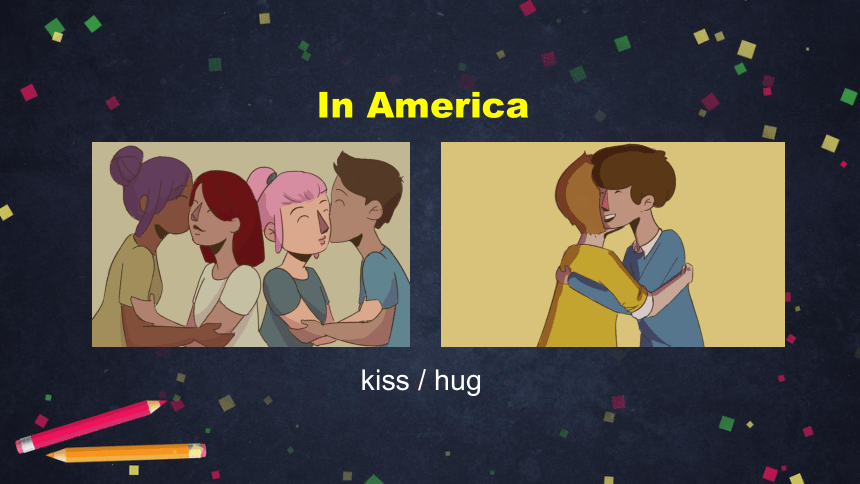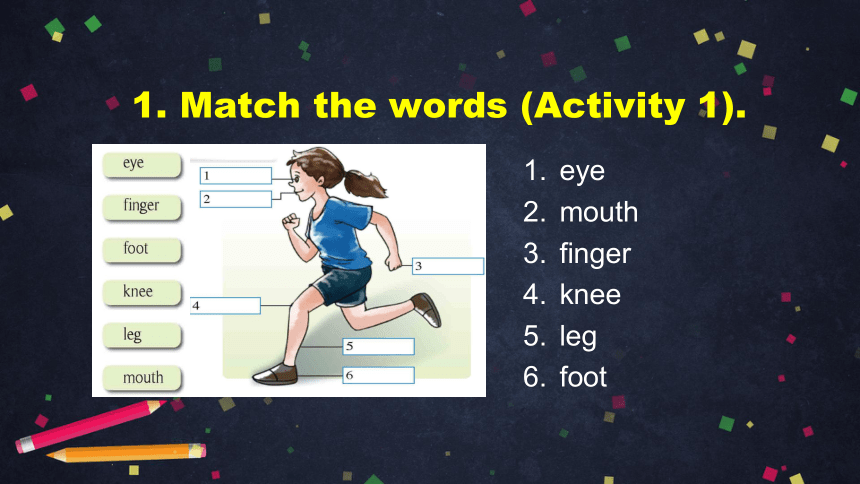Module 11 Body language Unit 2 Here are some ways to welcome them 课件(63张PPT)+内嵌音频
文档属性
| 名称 | Module 11 Body language Unit 2 Here are some ways to welcome them 课件(63张PPT)+内嵌音频 |  | |
| 格式 | zip | ||
| 文件大小 | 24.2MB | ||
| 资源类型 | 教案 | ||
| 版本资源 | 外研版 | ||
| 科目 | 英语 | ||
| 更新时间 | 2020-06-21 07:58:54 | ||
图片预览












文档简介
(共63张PPT)
M11
Unit
2
Here
are
some
ways
to
welcome
them.
初一年级
英语
different
ways
of
greeting
people
in
different
countries
Let’s
review!
shake
hands
and
smile
In
China
kiss
/
hug
In
America
kiss
3
times
In
Russia
touch
noses
In
New
Zealand
bow
In
Japan
In
India
put
hands
together
and
nod
head
put
hands
together
and
bow
In
Thailand
eye
mouth
finger
knee
leg
foot
1.
Match
the
words
(Activity
1).
South
American
North
American
foreign
adj.
the
Middle
East
Greece
They
walk___________.
arm
in
arm
to
raise
your
hand
and
move
it
from
side
to
side
wave
v.
rude
It’s
_______to
talk
and
use
a
cell
phone
in
movie
theaters
all
the
time.
personal
space
私人空间
1
2
3
4
5
Paragraph
1:
some
ways
to
___________
Paragraph
2:
the
way
of
______________
Paragraph
3:
the
way
of
______________
Paragraph
4:
the
way
of
______________
Paragraph
5:
the
way
of
______________
2.
Read
and
write.
1
2
3
4
5
Paragraph
1:
some
ways
to
___________
2.
Read
and
write.
Paragraph
1:
Our
new
foreign
students
are
going
to
arrive
very
soon,
and
here
are
some
ways
to
welcome
them.
Paragraph
1:
some
ways
to
___________
welcome
2.
Read
and
write.
Paragraph
1:
Our
new
foreign
students
are
going
to
arrive
very
soon,
and
here
are
some
ways
to
welcome
them.
Paragraph
2:
the
way
of
______________
2.
Read
and
write.
How
close
do
you
stand
when
you
talk
to
a
friend
You
can
stand
close
to
people
in
the
Middle
East
but
don’t
stand
too
close
to
North
Americans!
Give
them
more
personal
space.
Paragraph
2:
the
way
of
______________
standing
2.
Read
and
write.
How
close
do
you
stand
when
you
talk
to
a
friend
You
can
stand
close
to
people
in
the
Middle
East
but
don’t
stand
too
close
to
North
Americans!
Give
them
more
personal
space.
Paragraph
3:
the
way
of
______________
2.
Read
and
write.
How
about
touching
people
Chinese
girls
often
walk
arm
in
arm
with
their
friends.
South
Americans
sometimes
hold
your
arm
when
they
talk
to
you,
so
you
can’t
move
away!
But
in
Britain
many
people
don’t
like
other
people
to
touch
them
at
all.
Paragraph
3:
the
way
of
______________
touching
2.
Read
and
write.
How
about
touching
people
Chinese
girls
often
walk
arm
in
arm
with
their
friends.
South
Americans
sometimes
hold
your
arm
when
they
talk
to
you,
so
you
can’t
move
away!
But
in
Britain
many
people
don’t
like
other
people
to
touch
them
at
all.
Paragraph
4:
the
way
of
______________
2.
Read
and
write.
Do
you
look
at
people
when
you
talk
In
some
places,
it
isn’t
polite
to
look
at
people
when
you
talk,
but
in
other
countries
it
isn’t
polite
to
look
somewhere
else.
In
Britain
and
the
US,
people
usually
look
at
each
other
when
they
talk.
Paragraph
4:
the
way
of
______________
looking
at
people
2.
Read
and
write.
Do
you
look
at
people
when
you
talk
In
some
places,
it
isn’t
polite
to
look
at
people
when
you
talk,
but
in
other
countries
it
isn’t
polite
to
look
somewhere
else.
In
Britain
and
the
US,
people
usually
look
at
each
other
when
they
talk.
Paragraph
5:
the
way
of
______________
2.
Read
and
write.
And
how
do
you
say
goodbye
That’s
easy,
wave
to
say
goodbye.
But
be
careful!
In
Greece,
it’s
not
at
all
polite!
In
fact,
it’s
very
rude!
Paragraph
5:
the
way
of
______________
saying
goodbye
2.
Read
and
write.
And
how
do
you
say
goodbye
That’s
easy,
wave
to
say
goodbye.
But
be
careful!
In
Greece,
it’s
not
at
all
polite!
In
fact,
it’s
very
rude!
Paragraph
1:
some
ways
to
___________
Paragraph
2:
the
way
of
______________
Paragraph
3:
the
way
of
______________
Paragraph
4:
the
way
of
______________
Paragraph
5:
the
way
of
______________
standing
touching
looking
at
people
saying
goodbye
welcome
2.
Read
and
write.
Para
1:
Some
ways
to
welcome
the
foreign
students
Para
2:
the
way
of
standing
Para
3:
the
way
of
touching
Para
4:
the
way
of
looking
Para
5:
the
way
of
saying
goodbye
(
the
Middle
East
/
North
America
)
(
China
/
South
America
/
Britain
)
(
some
places
/
other
countries
/
Britain
/
the
US
)
(
Greece
)
Body
language
around
the
world
1.
Is
body
language
the
same
in
different
countries
2.
Is
it
all
right
to
stand
close
to
people
in
the
Middle
East
3.
Do
the
British
like
touching
people
4.
Do
Americans
look
at
people
when
they
talk
5.
Do
people
in
Greece
wave
goodbye
3.
Read
and
answer
(Activity
2).
1.
Is
body
language
the
same
in
different
countries
No,
it
isn’t.
Yes,
it
is.
2.
Is
it
all
right
to
stand
close
to
people
in
the
Middle
East
No,
they
don’t.
3.
Do
the
British
like
touching
people
Yes,
they
do.
4.
Do
Americans
look
at
people
when
they
talk
No,
they
don’t.
5.
Do
people
in
Greece
wave
goodbye
Stand
close
touch
each
other
look
at
people
when
talking
Britain
Middle
East
South
America
US
4.
Read
and
check
(Activity
3).
Stand
close
Britain
Middle
East
South
America
US
4.
Read
and
check
(Activity
3).
touch
each
other
Britain
Middle
East
South
America
US
4.
Read
and
check
(Activity
3).
look
at
people
when
talking
Britain
Middle
East
South
America
US
4.
Read
and
check
(Activity
3).
Stand
close
touch
each
other
look
at
people
when
talking
Britain
Middle
East
South
America
US
4.
Read
and
check
(Activity
3).
5.
Read
after
the
flash.
6.
Complete
the
passage
(Activity
4).
People
from
(1)
______
countries
have
different
body
language
from
us.
In
(2)
______,
people
don’t
like
to
touch
other
people,
but
in
South
America
they
like
to
(3)
____
on
to
you
so
you
can’t
(4)
_____
away.
Britain
fact
foreign
hold
move
personal
polite
rude
someone
wave
foreign
Britain
Lingling:
hold
move
6.
Complete
the
passage
(Activity
4).
Remember
to
give
(5)
________
from
North
America
lots
of
(6)
________
space.
In
some
countries
it
isn’t
(7)
_____
to
look
at
people
when
you
talk.
And
it
isn’t
polite
to
(8)
____
goodbye
in
Greece.
In
(9)
____,
it’s
quite
(10)
____
!
Britain
fact
foreign
hold
move
personal
polite
rude
someone
wave
Lingling:
someone
personal
polite
wave
fact
rude
6.
Complete
the
passage
(Activity
4).
How
does
Lingling
describe
different
body
language?
How
does
Lingling
give
her
advice
7.
Read
and
underline.
How
does
Lingling
describe
different
body
language?
You
can
do
something.
People
sometimes/often/usually
do
something.
People
don’t
like
somebody
to
do
something.
It
isn’t
polite
to
do
something.
It’s
very
rude
to
do
something.
How
to
describe
body
language
How
does
Lingling
give
her
advice?
Don’t
stand
too
close
to
North
Americans!
Give
them
more
personal
space.
Wave
to
say
goodbye.
But
be
careful!
Imperative
Sentence
祈使句
Rules规则:
祈使句无主语;
主语you常省去;
动词原形当谓语,
Don’t句首变否定;
加强语气加感叹号!
How
to
give
advice
Some
foreign
students
come
to
your
school,
and
study
with
you
for
a
month.
Please
make
a
list
of
your
class
rules
for
them.
8.
Imagine
and
list
(Activity
5&6).
How
to
list
class
rules:
8.
Imagine
and
list
(Activity
5&6).
individual
behavior
norm
个人行为规范
classroom
norm
课堂规范
how
to
treat(对待)each
other
Possible
answers:
Don’t
be
late
for
class.
Don’t
eat
food
in
class.
Don’t
fight
in
the
classroom.
Keep
the
classroom
clean.
classroom
norms
课堂规范
8.
Imagine
and
list
(Activity
5&6).
Possible
answers:
Put
up
your
hands
if
you
want
to
answer
a
question
in
class.
Ask
the
teacher
when
you
need
to
leave
the
class.
classroom
norms
课堂规范
8.
Imagine
and
list
(Activity
5&6).
Possible
answers:
Respect
and
love
each
other.
Help
each
other
in
a
good
way.
Don’t
push
anyone
when
in
line.
Don’t
take
another
student’s
things.
how
to
treat(对待)each
other
8.
Imagine
and
list
(Activity
5&6).
Possible
answers:
Laugh
with
people,
but
never
at
anyone.
Never
hit,
push,
injure
or
threaten
another
student.
Cooperate
with
your
group.
Allow
others
to
talk
without
interrupting.
how
to
treat(对待)each
other
8.
Imagine
and
list
(Activity
5&6).
Possible
answers:
Be
responsible
for
your
behavior
(行为).
Be
clear
about
individual
(个人的)
work
and
group
work.
individual
behavior
norms
个人行为规范
8.
Imagine
and
list
(Activity
5&6).
Possible
answers:
Don’t
shout.
Learn
to
take
notes.
Use
polite
language.
Finish
your
homework
on
time.
individual
behavior
norms
个人行为规范
8.
Imagine
and
list
(Activity
5&6).
1.
Read
the
passage
on
P68.
2.
Do
you
think
Lingling’s
passage
is
perfect
Please
collect
more
information
about
different
body
language
around
the
world
to
help
improve
Lingling’s
passage.
Homework.
Thank
you
for
listening.
M11
Unit
2
Here
are
some
ways
to
welcome
them.
初一年级
英语
different
ways
of
greeting
people
in
different
countries
Let’s
review!
shake
hands
and
smile
In
China
kiss
/
hug
In
America
kiss
3
times
In
Russia
touch
noses
In
New
Zealand
bow
In
Japan
In
India
put
hands
together
and
nod
head
put
hands
together
and
bow
In
Thailand
eye
mouth
finger
knee
leg
foot
1.
Match
the
words
(Activity
1).
South
American
North
American
foreign
adj.
the
Middle
East
Greece
They
walk___________.
arm
in
arm
to
raise
your
hand
and
move
it
from
side
to
side
wave
v.
rude
It’s
_______to
talk
and
use
a
cell
phone
in
movie
theaters
all
the
time.
personal
space
私人空间
1
2
3
4
5
Paragraph
1:
some
ways
to
___________
Paragraph
2:
the
way
of
______________
Paragraph
3:
the
way
of
______________
Paragraph
4:
the
way
of
______________
Paragraph
5:
the
way
of
______________
2.
Read
and
write.
1
2
3
4
5
Paragraph
1:
some
ways
to
___________
2.
Read
and
write.
Paragraph
1:
Our
new
foreign
students
are
going
to
arrive
very
soon,
and
here
are
some
ways
to
welcome
them.
Paragraph
1:
some
ways
to
___________
welcome
2.
Read
and
write.
Paragraph
1:
Our
new
foreign
students
are
going
to
arrive
very
soon,
and
here
are
some
ways
to
welcome
them.
Paragraph
2:
the
way
of
______________
2.
Read
and
write.
How
close
do
you
stand
when
you
talk
to
a
friend
You
can
stand
close
to
people
in
the
Middle
East
but
don’t
stand
too
close
to
North
Americans!
Give
them
more
personal
space.
Paragraph
2:
the
way
of
______________
standing
2.
Read
and
write.
How
close
do
you
stand
when
you
talk
to
a
friend
You
can
stand
close
to
people
in
the
Middle
East
but
don’t
stand
too
close
to
North
Americans!
Give
them
more
personal
space.
Paragraph
3:
the
way
of
______________
2.
Read
and
write.
How
about
touching
people
Chinese
girls
often
walk
arm
in
arm
with
their
friends.
South
Americans
sometimes
hold
your
arm
when
they
talk
to
you,
so
you
can’t
move
away!
But
in
Britain
many
people
don’t
like
other
people
to
touch
them
at
all.
Paragraph
3:
the
way
of
______________
touching
2.
Read
and
write.
How
about
touching
people
Chinese
girls
often
walk
arm
in
arm
with
their
friends.
South
Americans
sometimes
hold
your
arm
when
they
talk
to
you,
so
you
can’t
move
away!
But
in
Britain
many
people
don’t
like
other
people
to
touch
them
at
all.
Paragraph
4:
the
way
of
______________
2.
Read
and
write.
Do
you
look
at
people
when
you
talk
In
some
places,
it
isn’t
polite
to
look
at
people
when
you
talk,
but
in
other
countries
it
isn’t
polite
to
look
somewhere
else.
In
Britain
and
the
US,
people
usually
look
at
each
other
when
they
talk.
Paragraph
4:
the
way
of
______________
looking
at
people
2.
Read
and
write.
Do
you
look
at
people
when
you
talk
In
some
places,
it
isn’t
polite
to
look
at
people
when
you
talk,
but
in
other
countries
it
isn’t
polite
to
look
somewhere
else.
In
Britain
and
the
US,
people
usually
look
at
each
other
when
they
talk.
Paragraph
5:
the
way
of
______________
2.
Read
and
write.
And
how
do
you
say
goodbye
That’s
easy,
wave
to
say
goodbye.
But
be
careful!
In
Greece,
it’s
not
at
all
polite!
In
fact,
it’s
very
rude!
Paragraph
5:
the
way
of
______________
saying
goodbye
2.
Read
and
write.
And
how
do
you
say
goodbye
That’s
easy,
wave
to
say
goodbye.
But
be
careful!
In
Greece,
it’s
not
at
all
polite!
In
fact,
it’s
very
rude!
Paragraph
1:
some
ways
to
___________
Paragraph
2:
the
way
of
______________
Paragraph
3:
the
way
of
______________
Paragraph
4:
the
way
of
______________
Paragraph
5:
the
way
of
______________
standing
touching
looking
at
people
saying
goodbye
welcome
2.
Read
and
write.
Para
1:
Some
ways
to
welcome
the
foreign
students
Para
2:
the
way
of
standing
Para
3:
the
way
of
touching
Para
4:
the
way
of
looking
Para
5:
the
way
of
saying
goodbye
(
the
Middle
East
/
North
America
)
(
China
/
South
America
/
Britain
)
(
some
places
/
other
countries
/
Britain
/
the
US
)
(
Greece
)
Body
language
around
the
world
1.
Is
body
language
the
same
in
different
countries
2.
Is
it
all
right
to
stand
close
to
people
in
the
Middle
East
3.
Do
the
British
like
touching
people
4.
Do
Americans
look
at
people
when
they
talk
5.
Do
people
in
Greece
wave
goodbye
3.
Read
and
answer
(Activity
2).
1.
Is
body
language
the
same
in
different
countries
No,
it
isn’t.
Yes,
it
is.
2.
Is
it
all
right
to
stand
close
to
people
in
the
Middle
East
No,
they
don’t.
3.
Do
the
British
like
touching
people
Yes,
they
do.
4.
Do
Americans
look
at
people
when
they
talk
No,
they
don’t.
5.
Do
people
in
Greece
wave
goodbye
Stand
close
touch
each
other
look
at
people
when
talking
Britain
Middle
East
South
America
US
4.
Read
and
check
(Activity
3).
Stand
close
Britain
Middle
East
South
America
US
4.
Read
and
check
(Activity
3).
touch
each
other
Britain
Middle
East
South
America
US
4.
Read
and
check
(Activity
3).
look
at
people
when
talking
Britain
Middle
East
South
America
US
4.
Read
and
check
(Activity
3).
Stand
close
touch
each
other
look
at
people
when
talking
Britain
Middle
East
South
America
US
4.
Read
and
check
(Activity
3).
5.
Read
after
the
flash.
6.
Complete
the
passage
(Activity
4).
People
from
(1)
______
countries
have
different
body
language
from
us.
In
(2)
______,
people
don’t
like
to
touch
other
people,
but
in
South
America
they
like
to
(3)
____
on
to
you
so
you
can’t
(4)
_____
away.
Britain
fact
foreign
hold
move
personal
polite
rude
someone
wave
foreign
Britain
Lingling:
hold
move
6.
Complete
the
passage
(Activity
4).
Remember
to
give
(5)
________
from
North
America
lots
of
(6)
________
space.
In
some
countries
it
isn’t
(7)
_____
to
look
at
people
when
you
talk.
And
it
isn’t
polite
to
(8)
____
goodbye
in
Greece.
In
(9)
____,
it’s
quite
(10)
____
!
Britain
fact
foreign
hold
move
personal
polite
rude
someone
wave
Lingling:
someone
personal
polite
wave
fact
rude
6.
Complete
the
passage
(Activity
4).
How
does
Lingling
describe
different
body
language?
How
does
Lingling
give
her
advice
7.
Read
and
underline.
How
does
Lingling
describe
different
body
language?
You
can
do
something.
People
sometimes/often/usually
do
something.
People
don’t
like
somebody
to
do
something.
It
isn’t
polite
to
do
something.
It’s
very
rude
to
do
something.
How
to
describe
body
language
How
does
Lingling
give
her
advice?
Don’t
stand
too
close
to
North
Americans!
Give
them
more
personal
space.
Wave
to
say
goodbye.
But
be
careful!
Imperative
Sentence
祈使句
Rules规则:
祈使句无主语;
主语you常省去;
动词原形当谓语,
Don’t句首变否定;
加强语气加感叹号!
How
to
give
advice
Some
foreign
students
come
to
your
school,
and
study
with
you
for
a
month.
Please
make
a
list
of
your
class
rules
for
them.
8.
Imagine
and
list
(Activity
5&6).
How
to
list
class
rules:
8.
Imagine
and
list
(Activity
5&6).
individual
behavior
norm
个人行为规范
classroom
norm
课堂规范
how
to
treat(对待)each
other
Possible
answers:
Don’t
be
late
for
class.
Don’t
eat
food
in
class.
Don’t
fight
in
the
classroom.
Keep
the
classroom
clean.
classroom
norms
课堂规范
8.
Imagine
and
list
(Activity
5&6).
Possible
answers:
Put
up
your
hands
if
you
want
to
answer
a
question
in
class.
Ask
the
teacher
when
you
need
to
leave
the
class.
classroom
norms
课堂规范
8.
Imagine
and
list
(Activity
5&6).
Possible
answers:
Respect
and
love
each
other.
Help
each
other
in
a
good
way.
Don’t
push
anyone
when
in
line.
Don’t
take
another
student’s
things.
how
to
treat(对待)each
other
8.
Imagine
and
list
(Activity
5&6).
Possible
answers:
Laugh
with
people,
but
never
at
anyone.
Never
hit,
push,
injure
or
threaten
another
student.
Cooperate
with
your
group.
Allow
others
to
talk
without
interrupting.
how
to
treat(对待)each
other
8.
Imagine
and
list
(Activity
5&6).
Possible
answers:
Be
responsible
for
your
behavior
(行为).
Be
clear
about
individual
(个人的)
work
and
group
work.
individual
behavior
norms
个人行为规范
8.
Imagine
and
list
(Activity
5&6).
Possible
answers:
Don’t
shout.
Learn
to
take
notes.
Use
polite
language.
Finish
your
homework
on
time.
individual
behavior
norms
个人行为规范
8.
Imagine
and
list
(Activity
5&6).
1.
Read
the
passage
on
P68.
2.
Do
you
think
Lingling’s
passage
is
perfect
Please
collect
more
information
about
different
body
language
around
the
world
to
help
improve
Lingling’s
passage.
Homework.
Thank
you
for
listening.
同课章节目录
- Module 1 Lost and found
- Unit 1 Whose bag is this?
- Unit 2 Are they yours?
- Unit 3 Language in use
- Module 2 What can you do ?
- Unit 1 I can play the piano
- Unit 2 I can run really fast
- Unit 3 Language in use
- Module 3 Making plans
- Unit 1 What are you going to do at the weekends?
- Unit 2 We're going to cheer the players.
- Unit 3 Language in use
- Module 4 Life in the future
- Unit 1 Everyone will study at home
- Unit 2 Every family will have a small plane.
- Unit 3 Language in use
- Module 5 Shopping
- Unit 1 What can I do for you?
- Unit 2 You can buy everything on the Internet
- Unit 3 Language in use
- Module 6 Around town
- Unit 1 Could you tell me how to get to the Nationa
- Unit 2 The London Eye is on your right.
- Unit 3 Language in use
- Revision module A
- Module 7 My past life
- Unit 1 I was born in a small village.
- Unit 2 I was born in Quincy.
- Unit 3 Language in use
- Module 8 Story time
- Unit 1 Once upon a time….
- Unit 2 Goldilocks hurried out of the house.
- Unit 3 Language in use
- Module 9 Life history
- Unit 1 He left school and began work at the age of
- Unit 2 He decided to be an actor.
- Unit 3 Language in use
- Module 10 A holiday journey
- Unit 1 What did you do?
- Unit 2 This morning we took a walk.
- Unit 3 Language in use
- Module 11 Body language
- Unit 1 They touch noses!
- Unit 2 Here are some ways to welcome them.
- Unit 3 Language in use
- Module 12 Western music
- Unit 1 It's so beautiful!
- Unit 2 Vienna is the centre of European classical
- Unit 3 Language in use
- Revision module B
